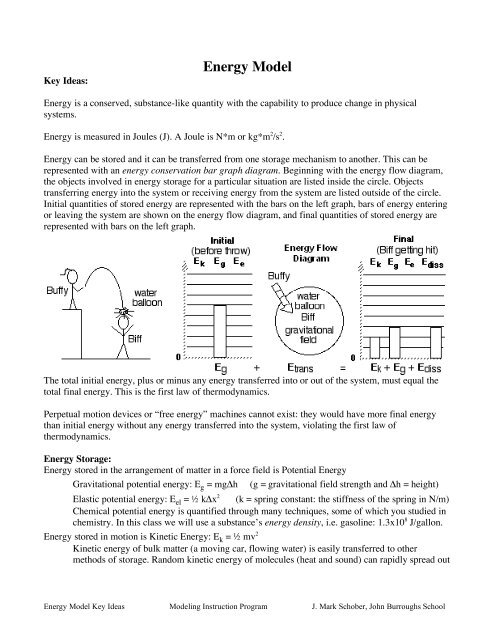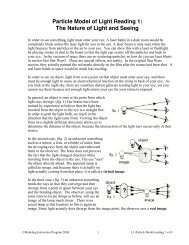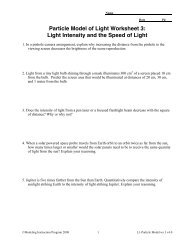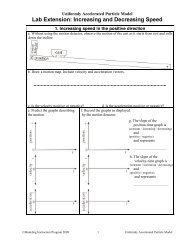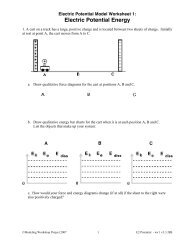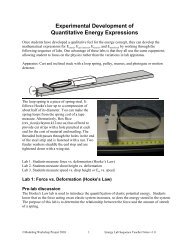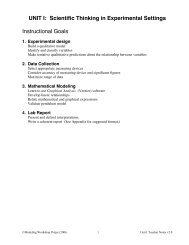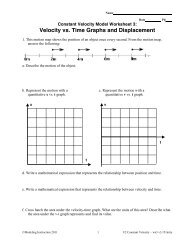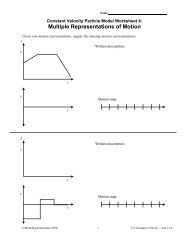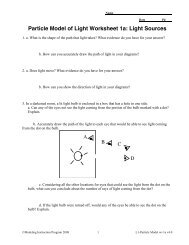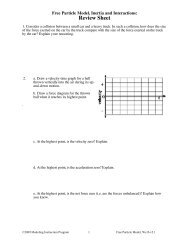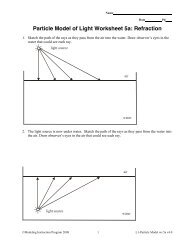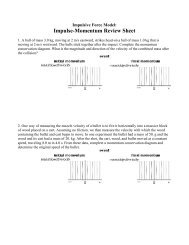Energy Model - Modeling Physics
Energy Model - Modeling Physics
Energy Model - Modeling Physics
You also want an ePaper? Increase the reach of your titles
YUMPU automatically turns print PDFs into web optimized ePapers that Google loves.
Key Ideas:<br />
<strong>Energy</strong> <strong>Model</strong><br />
<strong>Energy</strong> is a conserved, substance-like quantity with the capability to produce change in physical<br />
systems.<br />
<strong>Energy</strong> is measured in Joules (J). A Joule is N*m or kg*m 2 /s 2 .<br />
<strong>Energy</strong> can be stored and it can be transferred from one storage mechanism to another. This can be<br />
represented with an energy conservation bar graph diagram. Beginning with the energy flow diagram,<br />
the objects involved in energy storage for a particular situation are listed inside the circle. Objects<br />
transferring energy into the system or receiving energy from the system are listed outside of the circle.<br />
Initial quantities of stored energy are represented with the bars on the left graph, bars of energy entering<br />
or leaving the system are shown on the energy flow diagram, and final quantities of stored energy are<br />
represented with bars on the left graph.<br />
The total initial energy, plus or minus any energy transferred into or out of the system, must equal the<br />
total final energy. This is the first law of thermodynamics.<br />
Perpetual motion devices or “free energy” machines cannot exist: they would have more final energy<br />
than initial energy without any energy transferred into the system, violating the first law of<br />
thermodynamics.<br />
<strong>Energy</strong> Storage:<br />
<strong>Energy</strong> stored in the arrangement of matter in a force field is Potential <strong>Energy</strong><br />
Gravitational potential energy: E g = mg∆h<br />
(g = gravitational field strength and ∆h = height)<br />
Elastic potential energy: E el = ½ k∆x 2 (k = spring constant: the stiffness of the spring in N/m)<br />
Chemical potential energy is quantified through many techniques, some of which you studied in<br />
chemistry. In this class we will use a substance’s energy density, i.e. gasoline: 1.3x10 8 J/gallon.<br />
<strong>Energy</strong> stored in motion is Kinetic <strong>Energy</strong>: E k = ½ mv 2<br />
Kinetic energy of bulk matter (a moving car, flowing water) is easily transferred to other<br />
methods of storage. Random kinetic energy of molecules (heat and sound) can rapidly spread out<br />
<strong>Energy</strong> <strong>Model</strong> Key Ideas <strong>Model</strong>ing Instruction Program J. Mark Schober, John Burroughs School
to more molecules and become untransferrable to other storage modes. Unrecoverable internal<br />
energy in a system is called E dissipated , and incorrectly but commonly referred to as energy “lost.”<br />
Friction is a mechanism for dissipating the kinetic energy of bulk matter to random molecular kinetic<br />
energy of thermal and sonic energy storage. E diss = F∆x where the force and the motion are in opposite<br />
directions.<br />
Once energy has been dissipated, it cannot be transferred back to useful energy storage mechanisms.<br />
This is the second law of thermodynamics.<br />
<strong>Energy</strong> Transfer:<br />
<strong>Energy</strong> can be transferred in or out of a physical system in three ways:<br />
A. working – energy is transferred by forces that cause displacements.<br />
E trans by working = F∆x where the force and the motion are in the same direction<br />
On a force vs. displacement graph, E trans by working is the area under the graph.<br />
B. heating – temperature is a measure of the average kinetic energy of the molecules of a substance.<br />
Temperature differences between a system and its surroundings cause energy to be transferred<br />
from the warmer object to the cooler object.<br />
C. electromagnetic radiation (such as visible light, microwaves, ultraviolet light and infrared light) can<br />
transfer energy. Matter loses kinetic energy as it emits electromagnetic radiation and gains<br />
kinetic energy when absorbing electromagnetic radiation.<br />
Power is the rate of energy transfer, measured in Watts. A Watt is a Joule of energy transferred per<br />
second. A 60 Watt light bulb transfers 60 Joules of electrical potential energy to light and heat each<br />
second.<br />
<strong>Energy</strong> and Society:<br />
Earth has finite resources: air, water, fossil fuels, arable land, etc . . .<br />
The trend of increasing consumption of finite resources is unsustainable.<br />
Population growth is the most significant factor increasing resource consumption.<br />
Useful Numbers:<br />
1 horsepower (hp) is equal to 746 Watts<br />
A kilowatt-hour (kWh) is a kW x 1 hour or 3,600,000 Joules. One kWh costs an average of 7.6 cents in<br />
the U.S.<br />
A food Calorie is 4186 Joules. One Calorie is the amount of energy required to raise the temperature of<br />
1 kg of water 1˚Celsius.<br />
1 British Thermal Unit (BTU) is the amount of energy required to raise the temperature of 1 pound of<br />
water 1˚Farenheit. 1 BTU = 1055 Joules.<br />
1 Quad = 1 Quadrillion BTU’s = 10 15 BTU’s. This is a useful unit for world energy use.<br />
<strong>Energy</strong> <strong>Model</strong> Key Ideas <strong>Model</strong>ing Instruction Program J. Mark Schober, John Burroughs School


